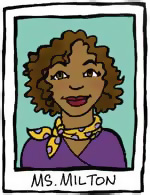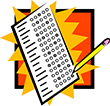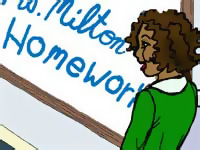What does Ms. Milton need to know about students with visual impairments?
Page 2: Responsibilities of the General Education Teacher
 Ms. Milton has many questions about her role and responsibilities for instructing and assessing Evan and Emily. Will she have to learn braille? Where can she get materials that are in braille or large print? How do the assistive technology devices work? Most importantly, she wonders how she can make the general education curriculum accessible.
Ms. Milton has many questions about her role and responsibilities for instructing and assessing Evan and Emily. Will she have to learn braille? Where can she get materials that are in braille or large print? How do the assistive technology devices work? Most importantly, she wonders how she can make the general education curriculum accessible.
While Ms. Milton reviews Evan and Emily’s individualized education programs (IEPs), she notes the various individuals who are knowledgeable about the students’ needs or who will be working closely with them. She decides to meet with each.
individualized education program (IEP)
A working document for students with disabilities, an individualized education program (IEP) specifies individualized learning goals and objectives, in addition to any accommodations, modifications, and related services the student may require in order to participate in school curriculum and activities and to maximize his or her learning.
- Teacher of students with visual impairments (TVI)
- Orientation and mobility specialist (O&M)
- Paraprofessional
- Family (including the students)
- Other professionals
By talking to each of these individuals, Ms. Milton learns not only about their roles but also more specifically about her own role and responsibilities in instruction, assessment, and technical assistance or support for students with visual disabilities.
Instruction

The general education teacher:
- Instructs all students in the general education classroom in core academic curriculum
- Implements suggestions and strategies for teaching the core curriculum to students with visual impairments
- Supports students with visual impairments when students use disability-specific skills, such as those found in the expanded core curriculum (ECC)
x
Expanded Core Curriculum (ECC)
Refers to additional areas of instruction needed by students with visual disabilities. This curriculum is taught primarily by professionals such as the TVI and O&M specialist and includes:
 Compensatory skills, or functional skills, including communication modes (e.g., braille, large print, abacus)
Compensatory skills, or functional skills, including communication modes (e.g., braille, large print, abacus)- Orientation and mobility skills
- Social interaction skills
- Independent living skills (e.g., personal hygiene, food preparation, money management)
- Recreation and leisure skills
- Career education and professional skills
- Assistive technology skills
- Encourages students to practice strategies and skills taught by the TVI
- Familiarizes herself with the content of the IEP (e.g., the students’ strengths and weaknesses, academic objectives)
Assessment

The general education teacher:
- Conducts accessible academic assessments for all students (e.g., grade-level achievement tests, writing samples, chapter tests) to determine their progress in the general education classroom
- Creates IEP goals regarding the general education curriculum based upon assessment results and the needs of students with visual impairments
Technical Assistance or Support

The general education teacher:
- Collaborates in advance with individuals to make certain that instructional materials can be provided in alternative formats in a timely fashion
- Consults regularly with students, families, and specialists for assessment and instructional purposes
- Provides information for meetings, including IEP meetings, regarding academic achievement
 Through these conversations Ms. Milton gains a lot of important information about teaching Evan and Emily. For example, she learns that she needs to make accommodations for Emily when she presents information in the classroom. She can do this by writing in large print and by using dark colors against the whiteboard. Ms. Milton also learns that she needs to reinforce Evan’s orientation and mobility skills by encouraging him to independently navigate the school instead of having a classmate help him.
Through these conversations Ms. Milton gains a lot of important information about teaching Evan and Emily. For example, she learns that she needs to make accommodations for Emily when she presents information in the classroom. She can do this by writing in large print and by using dark colors against the whiteboard. Ms. Milton also learns that she needs to reinforce Evan’s orientation and mobility skills by encouraging him to independently navigate the school instead of having a classmate help him.